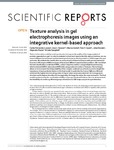Texture Analysis in Gel Electrophoresis Images Using an Integrative Kernel-Based Approach

Use este enlace para citar
http://hdl.handle.net/2183/17437Coleccións
Metadatos
Mostrar o rexistro completo do ítemTítulo
Texture Analysis in Gel Electrophoresis Images Using an Integrative Kernel-Based ApproachAutor(es)
Data
2016-01-13Cita bibliográfica
Fernández-Lozano C, Seoane JA, Gestal M, Gaunt TR, Dorado J, Pazos A, et al. Texture analysis in gel electrophoresis images using an integrative kernel-based approach. Nature [Internet]. 2016 Ene 13;19256. (Scientific Reports; 6).
Resumo
[Abstract] Texture information could be used in proteomics to improve the quality of the image analysis of proteins separated on a gel. In order to evaluate the best technique to identify relevant textures, we use several different kernel-based machine learning techniques to classify proteins in 2-DE images into spot and noise. We evaluate the classification accuracy of each of these techniques with proteins extracted from ten 2-DE images of different types of tissues and different experimental conditions. We found that the best classification model was FSMKL, a data integration method using multiple kernel learning, which achieved AUROC values above 95% while using a reduced number of features. This technique allows us to increment the interpretability of the complex combinations of textures and to weight the importance of each particular feature in the final model. In particular the Inverse Difference Moment exhibited the highest discriminating power. A higher value can be associated with an homogeneous structure as this feature describes the homogeneity; the larger the value, the more symmetric. The final model is performed by the combination of different groups of textural features. Here we demonstrated the feasibility of combining different groups of textures in 2-DE image analysis for spot detection.
Palabras chave
Data mining
Image processing
Machine learning
Proteome informatics
Image processing
Machine learning
Proteome informatics
Versión do editor
Dereitos
Atribución 3.0 España






